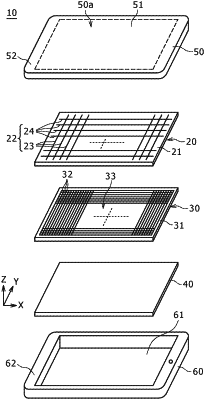| CPC G06F 3/04845 (2013.01) [G06F 3/04883 (2013.01); G06F 3/0443 (2019.05); G06F 3/0446 (2019.05); G06F 3/048 (2013.01); G06F 3/0488 (2013.01)] | 17 Claims |

|
1. An integrated circuit configured to control a position detection sensor including a detection region, which is larger than a display region of a display layered with the position detection sensor, the integrated circuit comprising:
a memory device including processor-executable instructions; and
a processor which, when loaded with the processor-executable instructions, performs:
periodically detecting a pointer touch on the position detection sensor at a defined time cycle;
determining positions of the pointer touch on the position detection sensor and storing the positions in the memory device;
determining whether or not to output a position of a first pointer touch to a control circuit, which is external to the processor, based on a position of a second pointer touch that is detected at a later timing later in time than the first pointer touch, so as to reduce a possibility of the first pointer touch being used for erroneous touch detection;
storing the position of the first pointer touch in the memory device until the later timing to reduce the possibility of erroneous touch detection;
in response to determining, at the later timing, to output the position of the first pointer touch, outputting the position of the first pointer touch to the control circuit to control a display image on the display based on correct touch detection;
in response to determining, at the later timing, to not output the position of the first pointer touch, continuing to store the position of the first pointer touch in the memory device without outputting the position of the first pointer touch to the control circuit to reduce the possibility of erroneous touch detection; and
in response to the position of the first pointer touch being outside the display region and the position of the second pointer touch being inside the display region, deriving an edge position at which a line connecting the position of the first pointer touch and the position of the second pointer touch intersects an edge of the display region.
|